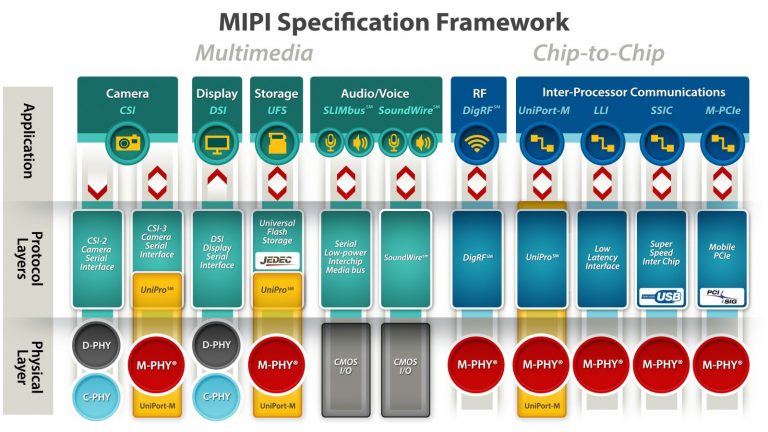The white paper “Exploring the Latest Innovations in MIPI D-PHY and MIPI C-PHY” details the latest developments in these two critical high-speed interface technologies, highlighting how they evolve to meet modern demands in camera and display systems across automotive, industrial, healthcare, and XR applications.

The evolution of MIPI D-PHY and MIPI C-PHY reflects the ongoing push toward higher performance and power-efficient data interfaces in camera and display systems. Originally developed for the mobile industry, both PHY types have significantly matured to support diverse applications in automotive, healthcare, industrial vision, and extended reality (XR). These advancements are essential to accommodate surging data rates driven by higher resolutions, expanded frame rates, and real-time image processing.
MIPI D-PHY, introduced in 2009, has incrementally increased its per-lane throughput from 2.5 Gbps to 11 Gbps over several specification versions. Key to supporting these higher rates are signal integrity enhancements such as transmitter de-emphasis and receiver Continuous Time Linear Equalization (CTLE), first introduced in v2.0. Version 3.5 added non-linear Decision Feedback Equalization (DFE) to further improve signal performance, especially in the 6–11 Gbps range. These techniques help mitigate channel losses across increasingly complex physical environments including PCB traces, packages, and connectors.
The reliability challenges that arose as silicon geometries shrank were tackled by introducing new signaling modes. The original 1.2V LVCMOS signaling used for low-power control became problematic in modern nodes with lower core voltages. MIPI D-PHY responded by offering LVLP mode to lower the voltage swing to 0.95V and ultimately developed the Alternate Low Power (ALP) mode. ALP mode discards the LP transmitter/receiver entirely, reusing the high-speed circuits for low power signaling. This not only improves leakage characteristics and reduces IO loading but also enables the PHY to operate over longer channels, up to 4 meters.
The ALP signaling introduces the ALP-00 state, a collapsed differential mode where both wires are grounded, minimizing power during idle periods. Wake pulses and high-speed bursts are coordinated using embedded control signals, enhancing synchronization. Notably, ALP also supports fast lane turnaround, which significantly reduces latency in bidirectional interfaces compared to legacy LP-mode lane switching. Combined with spread spectrum clocking, first introduced in v2.0 to mitigate EMI, MIPI D-PHY’s power and emissions profile is increasingly well-suited for automotive and industrial-grade deployments.
In a major architectural shift, MIPI D-PHY v3.5 introduced Embedded Clock Mode (ECM). In ECM, clock information is no longer carried on a dedicated lane but embedded in the data stream using 128b/132b encoding with clock and data recovery (CDR). This allows the clock lane to be repurposed as a fifth data lane, increasing throughput by 25% in common configurations. ECM also reduces EMI by eliminating the always-on toggling clock line and permits skew-insensitive timing between data lanes. However, the trade-off is reduced backward compatibility: ECM-only PHYs cannot interoperate with older Forwarded Clock Mode (FCM)-only devices.
MIPI C-PHY, launched in 2014, uses a 3-wire lane and a ternary signaling method to achieve efficient data encoding. The original 6-wirestate configuration encoded 16 bits in 7 symbols for an encoding efficiency of 2.28x. As symbol rates increased from 2.5 to 6 Gsps, data rates rose to 13.7 Gbps per lane. Equalization support was expanded in versions 1.2 and 2.0 through advanced TxEQ, CTLE, and various training sequences. Low power features were also introduced, including LVHS, LVLP, and ALP modes, often mirroring MIPI D-PHY enhancements while adapting them to MIPI C-PHY’s unique signaling format.
The landmark change came with MIPI C-PHY v3.0 and the 18-Wirestate mode. This innovation retains the same 3-wire lane interface but increases encoding efficiency to 3.55x by introducing 18 distinct differential states across wire pairs. With this, the PHY can achieve up to 24.84 Gbps per lane on short channels. New encoding schemes and state transitions were developed, with each symbol defined by a 5-bit code representing polarity, rotation, and flip attributes. The additional signaling levels require multi-level slicers in the receiver and increased TX power but enable significantly greater throughput.
The 18-Wirestate system also introduces a more sophisticated lane mapping and control mechanism. By embedding turnaround codes into the last transmitted symbol burst, MIPI C-PHY accelerates lane reversal, improving duplex performance. Furthermore, signal integrity is preserved through careful voltage slicing and receiver sensitivity enhancements, ensuring reliability despite reduced signal-to-noise ratio due to the multi-level signaling.
Together, the continued evolution of MIPI D-PHY and MIPI C-PHY demonstrates the MIPI Alliance’s focus on scalable, forward-compatible solutions that can bridge mobile, automotive, and emerging computing environments.
You can read the full whitepaper here.
Also Read:
Mixel at the 2025 Design Automation Conference #62DAC
2025 Outlook with Justin Endo of Mixel
MIPI solutions for driving dual-display foldable devices
Share this post via:





Comments
There are no comments yet.
You must register or log in to view/post comments.